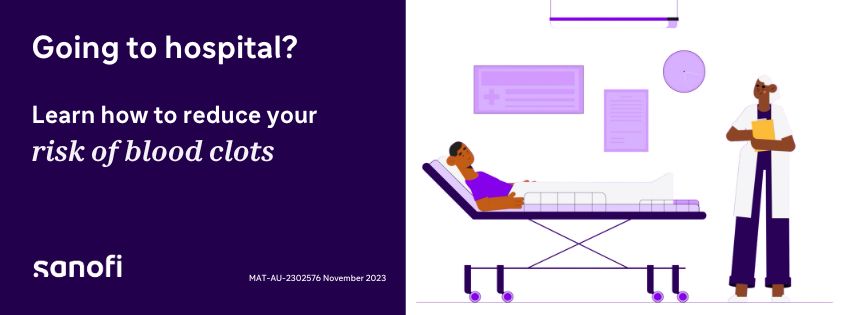
Australians who require a hospital stay may be unaware of some simple measures they could take to save them from developing a blood clot1 – a condition where blood flow is blocked from circulating around the body.
While Aussies often associate air travel with a risk of developing a blood clot and recognise the need to move around in the cabin to increase blood flow, the truth is that air travel increases your risk of developing a clot four-fold, while a hospital stay increases your risk 100-fold.1,2
While it is understandable that developing a blood clot isn’t top of mind for Australians who are going into hospital or being discharged, it is important that people know if they are at risk.
Hospitals have protocols in place for reducing clot risk, but the concern comes when patients are discharged and are no longer under the care of their medical team.
Around 17,000 Australians develop a blood clot each year, so this is not a minor issue.3
The first step in protecting you and your loved ones against a blood clot is to understand what causes a blood clot, and what increases your risk.
Blood clotting isn’t always bad – in fact, the body’s ability to clot can be lifesaving in preventing blood loss. The problem occurs when a clot develops in the wrong place and prevents blood flow.
Blood clots can be caused by underlying health conditions, medications, damage to blood vessels and restrictions to blood flow.
When a blood clot occurs deep inside areas like arms, legs and the pelvis it is known as deep vein thrombosis. This can cause pain, tenderness, redness or swelling.
When a clot breaks apart and moves through the body, it can sometimes cause a blockage to the blood vessels in your lungs, which is called a pulmonary embolism and can be fatal. Symptoms include shortness of breath, coughing up blood, chest pain, faintness and loss of consciousness.
Experts believe blood clots are responsible for around seven per cent of deaths each year,1 so it is important to understand if you are at risk before you are admitted to hospital and when you are discharged.
While there are many factors at play, the vast majority (three quarters of blood clots) occur in the first three months after a hospital stay,1 as immobility and lack of exercise are major contributing factors in developing this complication.
Cancer patients are up to seven times more at risk of developing blood clots in their veins, compared to people without cancer, with their risk further amplified by chemotherapy.4
Genetic and lifestyle factors can also play a role in whether you are at risk of developing life-threatening blood clots, such as being over the age of 60, being overweight or having a history of smoking.
You can take a simple risk assessment tool here to discover your risk of developing a blood clot.
There are simple measures you can take to reduce your risk of developing blood clots, such as regular exercise including walking and calf exercises. Drinking plenty of fluids is also an important step in lowering your risk.
Being aware of the symptoms of blood clots is also essential so you can alert your medical team if you experience any of the following symptoms
Understanding how at risk you are is important. Taking a few minutes to complete a short risk assessment tool that will enable you to have a conversation with your doctor about how to reduce your risk both in hospital and when you go home.
© Sanofi Australia and New Zealand, Talavera Corporate Centre, Building D, 12-24 Talavera Road, Macquarie Park, NSW 2113 MAT-AU-2302234 Prepared November 2023
References:

Understand your risk and learn how to discuss with your healthcare professional.